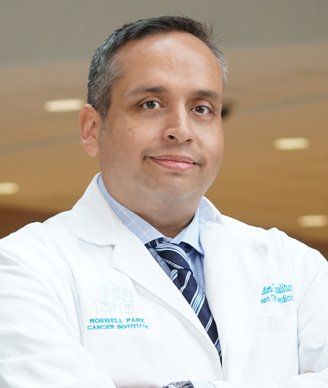Breast Implants Linked to Anaplastic Large-Cell Lymphoma
In this interview we discuss the link between breast implants and anaplastic large-cell lymphoma, a rare type of T-cell lymphoma.
Scott Chapin, MD

Francisco Hernandez-Ilizaliturri, MD

Today we are discussing the association between certain kinds of breast implants and an increased risk of a rare type of non-Hodgkin T-cell lymphoma known as anaplastic large-cell lymphoma (ALCL), with Scott Chapin, MD, head of Chapin Aesthetics in Doylestown, Pennsylvania, who is a consultant to Sientra, a maker of breast implants, as well as with Francisco Hernandez-Ilizaliturri, MD, chief of lymphoma and myeloma at the Roswell Park Cancer Institute in Buffalo, New York.
In 2011, the US Food and Drug Administration (FDA) issued a statement regarding a possible link between certain breast implants and the development of ALCL. In 2016, the World Health Organization recognized breast implant–associated ALCL as a lymphoma that can develop following implantation of breast implants. This March, the FDA issued an additional statement saying that the agency has received 359 cases of breast implant–associated ALCL. According to the FDA, the data so far suggest that this type of lymphoma occurs more frequently after implantation of textured-surface breast implants vs smooth-surface implants.
-Interviewed by Anna Azvolinsky
Cancer Network: Dr. Chapin, let’s start with you. Could you talk about the different breast implant options available and what factors you and your patients take into account when making the choice of which implant to pick in the context of this new data?
Dr. Chapin: The patients basically have two different choices for the kind of outer shell they can use with their implants-a smooth variety and a textured variety. On the inside, we have the saline implants and the silicone gel implants. The issue we are discussing today concerns the external shell of the implant. The smooth variety is a bit less stiff and has less rippling when it is in situ or in the patient. It is, however, somewhat slippery due to the smooth surface; it has what is known as a jackhammer effect, which will cause it to expand the pocket and make it slightly larger than the original pocket that we made for that implant. What can happen is that these implants can sometimes slide out of position, even if the patient had perfect surgery. This can happen 1 year, 2 years, or 5 years later.
The textured implants have fallen into favor throughout the world, and they were beginning to catch on here in the United States because they integrate with the surrounding tissue and, most importantly, they provide control to the surgeon. The outside of a textured implant has a little bit more surface area to integrate with the tissue; it’s sort of a Velcro effect that occurs, so that when you come back 1 year, 2 years, or 5 years later, the implants are still predictably in the same position that you placed them originally. There is less capsular contracture based on whatever study you read with these implants, meaning that the scar tissue becomes more inflamed less often than with the smooth type.
Cancer Network: Dr. Hernandez-Ilizaliturri, you’ve published a case report of a patient diagnosed with ALCL who had bilateral silicone breast implants. Could you talk about that case and what we know so far about the link between implants and an ALCL diagnosis?
Dr. Hernandez-Ilizaliturri: One thing to acknowledge is that breast implants associated with ALCL are rare. We reported a case in the literature of a patient who was referred to us for evaluation and treatment. This particular patient had breast implants that were silicone-based 8 years prior to the diagnosis of ALCL. The patient had started to complain about the asymmetry in size of her breasts, which led to an evaluation by her physicians and plastic surgeons. Imaging demonstrated the presence of an abnormality in the breast around the capsule and she underwent further surgical exploration. The patient was referred to our institution after she was suspected to have ALCL, and we conducted several imaging and laboratory studies to determine if the lymphoma had spread outside the breast tissue or outside of the implant area.
In this particular case, there was no evidence of systemic dissemination, which is rare, and the patient was treated with a multidisciplinary approach, which normally involves surgeons, a radiation oncologist, and a medical oncologist. She underwent resection of the breast implants, and the surgical margins were negative upon pathology review. After surgery, the patient did very well and didn’t require any further therapy. This is often the case for the majority of patients who undergo surgical resection, when the implants are removed and there is no evidence of dissemination of the lymphoma either locally or systemically; there is really no evidence that adding further therapy provides clinical benefit. The patient has been free of cancer for about 1 year, and we examine her periodically for recurrence.
Again, these are rare malignancies. In the medical literature, there are reports that suggest that the incidence of ALCL associated with breast implants is around 1 case for every 300,000 women who undergo breast implant surgical procedures. There is not a higher association with saline or silicone implants, but some physicians report that implants that have textured surfaces are associated with a higher incidence. Usually the typical symptoms that patients complain of is enlargement of the breast that is affected by the lymphoma, which leads to medical attention and evaluation. In general, clinical outcomes are excellent and overall survival is more than 10 years. It’s important to highlight that there is a time gap between the surgical implantation and the development of the lymphoma; on average, it happens about 8 years post-implantation. Since this clinical entity is rare and the outcome is good, we have to be careful not to produce some kind of panic in the community, while still remaining aware of these rare situations and monitoring the breasts of patients who undergo breast implant procedures.
Cancer Network: Dr. Chapin, as a plastic surgeon, how much should this potential risk of cancer be taken into account when women are considering breast implants and the type of implants? Is there a possible explanation for why textured implants are more likely to cause a higher risk for ALCL?
Dr. Chapin: The first thing I would like to address is that if a patient comes in and is concerned about this, we need to put it in perspective. As Dr. Hernandez-Ilizaliturri said, it depends on what you read but the incidence is anywhere from 1 in 300,000 to 1 in 30,000 if you have a breast implant that is textured. To put that in perspective, your lifetime chance of getting struck by lightning is 1 in 30,000. Your chance of getting breast cancer is 1 in 8, so these are really infinitesimally small chances of getting ALCL from breast implants. There are limitations as far as how well this is being reported and certainly the incidence could be more than what we currently think, but as of now, the incidence is quite low. So, I try to put this in perspective for my patients who are a bit scared about this news. I use textured implants all the time. I think they are wonderful and they have changed my practice. I have been practicing for 20 years and I have never had a patient with ALCL. If a patient had a previous capsular contraction, they do better with a textured implant. Another thing to consider is control for the surgeon. In just about every patient, I want control, so it is hard to make a decision against the textured implants based on a 1 in 300,000 risk, and I think that once most patients understand their risk, they usually go with the textured implant. That said, I always tell patients that I will put in the smooth implant if they prefer, but I give them the risks and benefits of each.
Researchers think that this link has something to do with the texturing of the implants, and that more aggressive texturing might have something to do with this ALCL risk. There could also be a bacterial cause: if you use certain components in your antibacterials during the procedure, you can decrease the rate of this bacteria being present. There is biocompatibility testing being performed by the French right now and they will have a report out by the end of the year. We are still learning more about this association, but the most important thing we can do for our patients is to put things in perspective and convey the low incidence.
Cancer Network: Dr. Hernandez-Ilizaliturri, for you as an oncologist, what else do we need to know about this association, and is there anything else you would like to add about monitoring women who already have implants, based on the number of cases and what we know so far about this link?
Dr. Hernandez-Ilizaliturri: I think that more research needs to be done to figure out why some patients develop this rare form of lymphoma. There is a hypothesis that has been entertained by pathologists and physicians that chronic inflammation can sometimes be seen in the context of an external device and can lead to an aberrant stimulation of the immune system, which can lead to a lymphoma. Certainly, the presence of bacteria can further stimulate inflammation, so chronic inflammatory responses from the immune system in response to the implant may play a role. However, it is still not well understood why this happens in 1 out of 300,000 patients who undergo this surgical procedure.
It is all about risk and benefit ratios. Patients need to be informed of the risks and benefits of a surgical procedure, and I think every patient must make a decision with their surgeons and primary care physicians. For patients who have been affected by a lymphoma like this, the clinical outcomes are excellent: the resection does cure the patient and then they are typically followed for 5 years and undergo physical examinations to check for recurrence. For patients who have implants and are concerned, it’s important for them to discuss the true incidence of these rare malignancies with their plastic surgeon and their physicians. What I always tell patients is that if they want to be proactive, what they can do is pay attention to their bodies, examine their breasts frequently, and report any changes in the breast shape or size to their physicians. That, hopefully, will help patients be more at ease in terms of the safety of breast implants.
Cancer Network: Thank you both so much for joining us today.